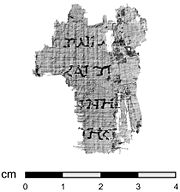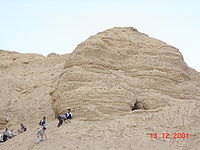
7Q5
Encyclopedia

Dead Sea scrolls
The Dead Sea Scrolls are a collection of 972 texts from the Hebrew Bible and extra-biblical documents found between 1947 and 1956 on the northwest shore of the Dead Sea, from which they derive their name...
, 7Q5 is the designation for a small papyrus
Papyrus
Papyrus is a thick paper-like material produced from the pith of the papyrus plant, Cyperus papyrus, a wetland sedge that was once abundant in the Nile Delta of Egypt....
fragment discovered in Qumran
Qumran
Qumran is an archaeological site in the West Bank. It is located on a dry plateau about a mile inland from the northwestern shore of the Dead Sea, near the Israeli settlement and kibbutz of Kalia...
Cave 7. The significance of this fragment is derived from an argument made by Jose O´Callaghan in his work ¿Papiros neotestamentarios en la cueva 7 de Qumrân? ("New Testament Papyri in Cave 7 at Qumran?") in 1972, later reasserted and expanded by German scholar Carsten Peter Thiede
Carsten Peter Thiede
Carsten Peter Thiede was a German archaeologist and New Testament scholar. He was also a member of PEN and a Knight of Justice in the Order of St John. Thiede often advanced theories that conflicted with the consensus of academic and theological scholarship...
in his work The Earliest Gospel Manuscript? in 1982. The assertion is that the previously unidentified 7Q5 is actually a fragment of the Gospel of Mark
Gospel of Mark
The Gospel According to Mark , commonly shortened to the Gospel of Mark or simply Mark, is the second book of the New Testament. This canonical account of the life of Jesus of Nazareth is one of the three synoptic gospels. It was thought to be an epitome, which accounts for its place as the second...
, chapter 6 verse 52-53. The majority of scholars have not been convinced by O'Callaghan's and Thiede's identification
and it is "now virtually universally rejected".
O'Callaghan's proposed identification
This shows the Greek text of Mark 6:52-53. Bold characters represent proposed identifications with characters from 7Q5:ου γαρ
συνηκαν επι τοις αρτοις,
αλλ ην αυτων η καρδια πεπωρω-
μενη. και διαπερασαντες [επι την γην]
ηλθον εις γεννησαρετ και
προσωρμισθησαν. και εξελ-
θοντων αυτων εκ του πλοιου ευθυς
επιγνοντες αυτον.
for they did not
understand concerning the loaves
but was their heart harden-
ed. And crossing over [unto the land]
they came unto Gennesaret and
drew to the shore. And com-
ing forth out of the boat immediately
they recognized him.
Argument

- First, the spacing before the word και
("and") signifies a paragraph break, which is consistent with the normative layout of Mark in early copies. Secondly, the combination of letters ννησ found in line 4 is highly characteristic and may point at the word Γεννησαρετ <Gennesaret GennesaretGennesaret was a town alloted to the tribe of Naphtali, called "Kinnereth" , sometimes in the plural form "Kinneroth" . In later times the name was gradually changed to Genezareth, Genezar and Gennesaret...
>, found three times in the New Testament. - Furthermore, a computer search "using the most elaborate Greek texts ... has failed to yield any text other than Mark 6:52-53 for the combination of letters identified by O’Callaghan et al. in 7Q5".
Several counterarguments exist.
- The spacing before the word και
("and") might be a paragraph break. But spacings of this width can be found in papyri sometimes even within words (Pap. Bodmer XXIV, plate 26; in Qumran in fragment 4Q122). Other examples in the Qumran texts show that the word και ("and") in many cases was separated with spacings - and this has in many cases nothing to do with the text's structure. - Although the sequence ννησ is unusual in Greek, the word εγεννησεν
("begot") also contains those four letters. In fact, this conjecture was proposed by the authors of the first edition (editio princeps) published in 1962. In such case the fragment might be part of some genealogy GenealogyGenealogy is the study of families and the tracing of their lineages and history. Genealogists use oral traditions, historical records, genetic analysis, and other records to obtain information about a family and to demonstrate kinship and pedigrees of its members...
. - In order to identify the fragment with Mark 6:52-53, one must account for the replacement of original δ
with τ in line 3, and, although such difference is not without parallel in ancient Greek where two similar meaning words might be confused, the suggested reading requires the misspelling of a prepositional prefix to create an unknown word. - As the lines of a column are always more or less of the same length, it must be assumed that the words επι την γην
("to the land") were omitted, a variant which is not attested elsewhere. - The identification of the last letter in line 2 with nu has been strongly disputed because it does not fit into the pattern of this Greek letter as it is clearly written in line 4.
- The computer search performed by Thiede assumed that all the disputed letter identifications made by O'Callaghan were correct. However, a similar search performed by scholar Daniel Wallace, but allowing other possible identifications for the disputed letters, found sixteen matches. If a computer search is performed with the undisputed letters of the fragment 7Q5 it will not find the text Mk 6,52-53, because the undisputed letter τ in line 3 does not fit to this text.
Significance
If 7Q5 were identified as and was deposited in the cave at Qumran by 68 AD, it would become the earliest known fragment of the New TestamentNew Testament
The New Testament is the second major division of the Christian biblical canon, the first such division being the much longer Old Testament....
, predating P52
Rylands Library Papyrus P52
The Rylands Library Papyrus P52, also known as the St John's fragment, is a fragment from a papyrus codex, measuring only 3.5 by 2.5 inches at its widest; and conserved with the Rylands Papyri at the John Rylands University Library , Manchester, UK...
by at least some if not many decades.
Since the amount of text in the manuscript is so small, even a confirmation of 7Q5 as Markan "might mean nothing more than that the contents of these few verses were already formalized, not necessarily that there was a manuscript of Mark's Gospel on hand". Since the entirety of the find in Cave 7 consists of fragments in Greek, it is possible that the contents of this cave are of a separate "Hellenized" library than the Hebrew texts found in the other caves. Additionally, as Robert Eisenman points out: "Most scholars agree that the scrolls were deposited in the cave in or around 68 AD, but often mistake this date...for the terminus ad quem for the deposit of the scrolls in the caves/cessation of Jewish habitation at the site, when it cannot be considered anything but the terminus a quo for both of these, i.e., not the latest but the earliest possible date for such a deposit and/or Jewish abandonment of the site. The actual terminus ad quem for both of these events, however difficult it may be to accept at first, is 136 AD."(italics his). So, for this is long after the currently accepted date range for the composition of Mark
Gospel of Mark
The Gospel According to Mark , commonly shortened to the Gospel of Mark or simply Mark, is the second book of the New Testament. This canonical account of the life of Jesus of Nazareth is one of the three synoptic gospels. It was thought to be an epitome, which accounts for its place as the second...
, according to Eisenman this would mean the even if it could be proved that 7Q5 is a Mark's fragment, an earlier composition date for the gospel could not be proved. However, Eisenman's objection can be confuted on paleographical grounds; in fact, the fragment has been analysed and dated paleographically, and the upper limit of its date is 50 AD.
See also
- 4Q1084Q1084Q108 is a fragment containing a portion of the Song of Songs in Hebrew. Fragments from three such scrolls were found in Cave 4 at Qumran...
- 4QMMT4QMMT4QMMT , also known as the Halakhic Letter, is one of the Dead Sea Scrolls that were discovered at Qumran in the West Bank. The manuscript is mainly concerned with the issue of the purity of liquid streams, a matter of great debate between the Pharisees and the Sadducees in later rabbinic...
- List of New Testament papyri
- List of New Testament uncials
Further reading
- Enste(2000), Stefan: Kein Markustext in Qumran. Eine Untersuchung der These: Qumran-Fragment 7Q5 = Mk 6,52-53, Freiburg/Göttingen 2000 (NTOA 45).
- Estrada, David and White, Jr., William: The First New Testament, Nashville/Thomas Nelson Inc. 1978, ISBN 0-8407-5121-4.

